The Kansas City Catholic Diocese Finds Itself Fighting a Slew of New Lawsuits over Abuse of Parishioners All Filed by One Determined Lawyer
By Kendrick Blackwood
The Pitch [Kansas City]
October 16, 2003
The woman who wants you to think there's a major pedophile priest scandal in Kansas City looks like she stepped out of a black-and-white movie.
The pageboy haircut and conservative attire not only give the impression that Rebecca Randles is missing from some 1950s courtroom drama but also match her personality. Cautious and smart, she's fully in control when she steps in front of a crowd of reporters to announce her latest lawsuit against the local Catholic diocese, yet she gives no sense that she's grandstanding. Hers is a cool but intense style that has garnered praise from clients and colleagues alike and seems to enthrall reporters.
Last week, Randles announced the fourth and fifth lawsuits she's filed in the past month claiming that priests in Kansas City sexually abused parishioners. More suits, she says, are forthcoming. A visit to her office, meanwhile, reveals shelves weighed down with files that document interviews Randles has conducted with Kansas Citians who say they were abused by local priests. She's adding more all the time -- five interviews in a single day, she says, is all she can handle before nearly collapsing from the effort.
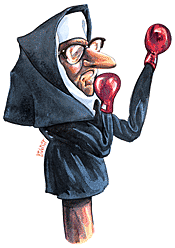 |
| Photo by Steve Walker |
At her press conferences, Randles hands out copies of her lawsuits as well as photographs of young victims and accused priests -- and it all seems so familiar. For the past decade, the nation's Catholic churches have been reeling from accusations that priests committed heinous acts against trusting young parishioners, that bishops conspired to keep those acts hidden, and that known predator priests were simply moved from parish to parish.
Major scandals in Boston, Phoenix, Los Angeles and Chicago have resulted in criminal investigations, lawsuits and huge settlements. Until last month, the Kansas City Diocese had weathered several allegations of abuse dating back decades but had largely escaped a major dustup -- in fact, it was seen as one diocese that had moved against priest abuse earlier than most. In 1988, a lay committee was formed locally to hear accusations of abuse, and in 1993, when Bishop Raymond Boland was appointed to lead the Kansas City-St. Joseph Diocese, one of his first acts was to announce a "zero tolerance" policy against molestation.
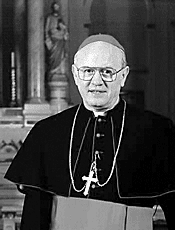 |
| Bishop Raymond Boland implemented a zero-tolerance abuse policy ten years ago. |
A decade later, however, Boland finds himself a defendant in each of the suits filed by Randles, even though none of the alleged sexual abuse occurred after Boland arrived:
Kenneth Landes alleges that the Rev. Hugh Monahan fondled him at St. Robert Bellarmine Parish beginning in the 1980s and as late as 1987. Landes, who now lives in California, says the abuse began when he was fifteen years old and involved rubdowns that Monahan gave and asked to receive in turn. "It went from shoulder to back to lower back to the top of my butt and everything. It just progressed," Landes says. "It very quickly became genital contact.... It was never making love. There was never an exchange of sentiments ... I was fifteen, and, yes, it did feel good. I had never experienced these kinds of feelings. It was hard to understand it being so bad when it felt so good. It was a big part of why, for so long, I was unable to accept the fact I was molested." Monahan is no longer a priest. His last known address was in Florida.
Another man, identified only as D.L.B., says that Monahan began sexually abusing him in 1974, when he was about ten years old. Besides the abuse allegations, Randles also charges the present diocese leadership with breach of contract for having stopped paying for D.L.B.'s counseling after twelve sessions.
Chris Biersmith, Monahan's own nephew, alleges that his uncle molested him over an eleven-year period beginning in 1971, while the boy was a parishioner at St. Peter's in Kansas City. Biersmith's is also a breach of contract suit, alleging that the diocese failed to pay for his counseling.
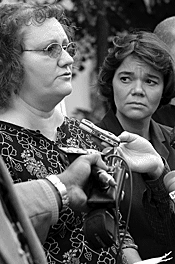 |
|
Teresa White (left), accompanied by Rebecca Randles, takes questions about her lawsuit. Photo by Gina Kaufmann |
Teresa White says the Rev. Francis McGlynn molested her and tried to rape her after she went to him for religious training at the St. Mary's parish in the early 1970s.
Frank Scheuring also alleges that McGlynn molested him in the early 1970s, while he was an altar boy at St. Mary's.
In her press conferences, Randles clearly aims to give the impression that her suits are part of a movement gaining momentum in Kansas City. In truth, she faces enormous legal obstacles by bringing to court allegations decades old. Similar lawsuits elsewhere in the country have won victims multimillion-dollar settlements -- even when alleged abusers were long out of the priesthood or dead. But in Missouri, such cases -- some brought by Randles -- have repeatedly been dismissed because they don't meet the statute of limitations.
Still, Randles, in her calm, determined style, continues to gather the harrowing stories of local men and women who were betrayed by men of the cloth and struggle in their adulthood with their memories. To them, she's a crusader. And Randles herself is undaunted by past failures in Missouri courts. This time, she says, she has a new strategy to make the Kansas City diocese pay for horrible crimes, even if they happened long ago.
Randles learned the art of battling the Catholic Church from the master -- St. Paul, Minnesota, lawyer Jeffrey Anderson.
"He's the man," Randles says.
Anderson has probably done more than any other attorney to make abuse by Catholic priests a national scandal. Since the mid-1980s, Anderson has filed more than 800 lawsuits around the country on behalf of clergy-abuse victims, winning more than $60 million in settlements. He's known not only for suing the church but also for spurning confidentiality agreements and going directly to the press with details of his cases. He's constantly in demand from reporters doing stories on priest abuse and from other lawyers seeking advice for how to succeed with their own lawsuits against the church.
Just two weeks ago, Anderson won a settlement from the Roman Catholic Archdiocese of Chicago, which agreed to pay more than $8 million to ten men and five women who said they were abused by eleven priests, none of whom still serve as ministers and some of whom are dead.
A pariah to defenders of the church, Anderson is blamed for developing a blueprint for bringing accusations against priests and dioceses, working the local media and pressing the church to fork over large settlements to avoid the high costs of trial.
Randles admits that she's taken a page from Anderson's playbook.
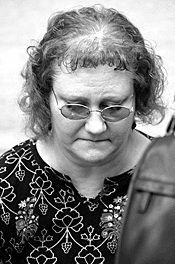 |
| White says her life has been hard since a priest's alleged sexual assault before her wedding day. |
She first worked with Anderson in 1991, when the Minnesota lawyer sued the Jefferson City Diocese on behalf of David Clohessy, who alleged that he'd been sexually abused by the Rev. John Whiteley over four years beginning in 1967, when he was eleven years old and living in Moberly, Missouri.
Randles got involved in the suit when Clohessy's therapist, Lucie Lee, a friend of hers, recommended her to Clohessy. "I just called her and dropped Lucy's name," Clohessy says. Five days later, Randles helped him by writing an amicus brief for his lawsuit.
Randles -- who had been representing clients abused by psychologists -- submitted a brief addressing Missouri's strict statute of limitations, which gives a victim of childhood sexual abuse just five years after his or her eighteenth birthday -- or three years after "the plaintiff discovers ... that the injury or illness was caused by child sexual abuse" -- to sue.
Clohessy argued that he had blocked out memories of his own abuse until they abruptly came back in 1987, while he was watching the movie Nuts, in which Barbra Streisand plays a murder suspect who struggles to make others believe her innocence.
Randles argued that the twenty years that had passed since the last time Whiteley touched Clohessy's penis didn't lessen the damage and shouldn't keep him from suing. She compared sexual-abuse victims to factory workers exposed to asbestos, who are required to file their claims only after they have developed lung cancer.
But Clohessy's lawsuit failed. Missouri's Supreme Court found that Clohessy's late recovery of abuse memories didn't fall under the statute of limitations.
Undaunted, Randles was energized by her first experience working with Anderson, and she set out to handle similar cases on her own. She explains her dedication to victims of abuse as a natural consequence of her upbringing.
"I've always been a very spiritual and religious person," says the lawyer, who also serves as a trustee at her alma mater, Southwest Baptist University in Bolivar, Missouri. "To see that these individuals have had that element ripped from them, to me, would be a huge loss."
Randles says her own childhood was bucolic. She grew up in Carthage, Missouri, where her father sold real estate and her mother stayed home. Her childhood was so idyllic, she says, that it may have contributed to her zeal.
"It's almost like survivor's guilt," she says.
At Southwest Baptist, Randles developed courtroom skills as a member of the debate team -- and met her future husband. She ultimately married fellow debater Billy Randles, who went to Harvard Law School and now works on the Philip Morris tobacco defense team for Kansas City firm Shook, Hardy & Bacon.
"If you are a poor boy from Arkansas and go to Harvard, the only way you are going to get all the loans paid back is if you go to work for a big firm," she says. And in her mind, anyway, there's not a lot in common between her clients and the smokers her husband faces in court. "The clients I have are true victims," she says. "There isn't any element of personal choice in what happens to them."
Randles got her own law degree from Baylor University. She worked for a lawyer in Boston for a year before moving to St. Louis in 1990. She and her husband moved to Kansas City two years later.
A year after Clohessy's lawsuit failed, Randles and another attorney took on their first abuse case on behalf of Henry R. Bachmann, who, like Clohessy, remembered his childhood abuse years after the fact. When his boss at the Savannah, Georgia, Port Authority chewed him out, Bachmann claimed that he suddenly remembered being repeatedly tied up, stripped and sodomized years before by St. Louis priest James L. Gummersbach in the basement of the Church of the Immaculate Conception.
Randles says the timing of the 1999 trial made things especially tough. Just a month before, Pope John Paul II's American tour had taken him to St. Louis, where he'd said mass for 104,000 people at the Trans World Dome. Still, a jury was swayed by witnesses who said they, too, had been fondled and stripped by Gummersbach, and it awarded Bachmann $1.2 million in damages.
But the state's Court of Appeals later struck down the decision, finding that, again, a case against a Missouri priest had simply been brought too late. "Allowing a plaintiff unlimited time to bring an action increases the potential for spurious claims and decreases the court's or jury's ability to determine the truth," the court wrote.
Other court decisions have added to the difficulty of suing the church in Missouri. The state's Supreme Court put up substantial hurdles when it rejected a suit by Michael Gibson, who claimed he had been molested at age seventeen by a priest in 1990. The precedent-setting ruling established a strict standard of proof for anyone who sues a religious organization in the state over the actions of its employees. Plaintiffs have to show not just that the church should have known about the abuse but also that the church did know and failed to act.
Attorney Bob Wells watched his own 1994 case on behalf of Nicholas Gray hit legal snags for the same reason. Gray charged that he had sex with the Rev. Thomas Ward for a decade, beginning when he was fourteen. But Wells says the Supreme Court's decision set the burden of proof so high that simply establishing that a sexual relationship had occurred was not sufficient. "We would have had to prove the diocese knew and failed to take action," Wells says. "It was going to be a lot of innuendo. It was essentially Nick's word against the priest's." Still, Wells managed to get a settlement for his client. He says he's barred from discussing the amount.
The same legal hurdles face Randles. But today, she says she has a new strategy for overcoming Missouri's barriers against old cases of abuse. For many victims, she says, it's the nationwide pedophile-priest scandal itself that has awakened them to their own victimhood. Some adults are only now becoming aware that what they experienced in the church was predatory and wrong.
Only when these victims have reached that "trigger" moment, she says, should the clock begin running that requires them to file lawsuits within three years.
She argues that the adults who now seek her out shouldn't be punished because decades of fear and doubt have kept them from coming forward earlier with stories they still can barely bring themselves to tell today.
Randles has talked with more than fifty local people who say they were victimized by priests. However, she won't be filing lawsuits on behalf of all of them. Even for Randles, some tales are simply too old or based on memories that are too sketchy or faded to have confidence in. She admits that one distraught woman whose recollections fill several file folders on her shelves is a victim of bad therapy, her "recovered memories" produced over years of questionable counseling.
But others are more compelling. Randles allowed the Pitch to sit in as one woman recounted a tale that for decades she'd kept from everyone she knew.
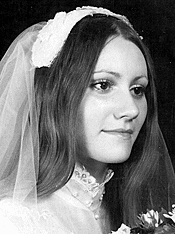 |
|
White says her life has been hard since a priest's alleged sexual assault before her wedding day. Photo by Robert Wilonsky |
Teresa White has warned that she'll break out in hives, and, as if on cue, as she begins telling her tale in Randles' office, red blotches emerge around her neck.
Randles is typing as quietly as she can on a laptop computer, hoping her note-taking will not intrude as White describes experiences that remain vivid in her mind, despite the passing of more than twenty years.
She remembers that she was seventeen or eighteen years old and engaged to be married. Her fianc� was Catholic, and her mother wanted a big church wedding, so White agreed to sign up for catechism classes at the St. Mary parish in Independence to learn about her fianc�'s religion. From the start, however, she found the Rev. Francis McGlynn's questions, conducted in private evening sessions, rather odd.
(Reached at his home, McGlynn declined to comment on the lawsuits.)
McGlynn, White says, seized on the idea that the young woman was not close to her father, who was busy running a restaurant. "He said, CEI can be the father to you you never had,'" White recalls.
As the meetings continued, McGlynn began getting physical. It started with embraces as she arrived for each session, but then he began giving her hugs as she left, too. "When he was hugging me, he was touching my bottom. He was touching my breasts," she says.
At first, she convinced herself that the contact was accidental. But as McGlynn's fondling became more brazen, she knew that wasn't the case. Blaming herself, she began wearing layers of baggy clothes and no makeup to her appointments.
"I thought it would protect me."
During White's first confession, McGlynn's questions drilled into her sex life. "I had to answer all of his questions, or I wouldn't be forgiven," she says. "From that point on, there wasn't any talking about religion. It was all sex."
Was she a virgin? Who had she had sex with? Were her legs really so long that they stuck out the car window? Did she make noise? Was there squirming? Did he do most of the moving? Did she?
McGlynn, meanwhile, spoke about the girls at the parish school. "They want me. They want to see my penis. They are curious about me for sex," she remembers him saying.
White says she turned down McGlynn's invitations to come to his room and that she wanted the sessions to stop. But she couldn't convince her fianc� to elope, and she couldn't think of another way to end the classes.
At a later session, McGlynn told White he was worried about her ability to have children. "He thought I was too small to have a baby," she says. "He said there was something he needed to do. He ordered me to come around the desk. I couldn't move. He kept ordering me and ordering me.
"He said first he had to measure me with his finger, then he had to measure me with his fist."
He did.
On what was to be their final night, McGlynn invited White into the sanctuary. He told her he had something to show her. The room was dark except for a small light at the altar. McGlynn blessed himself and led White to the last booth of the confessional. "He told me to be quiet.... Be quiet and just look in there."
As White leaned into the wooden booth, McGlynn grabbed her. He pressed his mouth over hers and groped for her crotch. "I couldn't breathe. I couldn't move. I couldn't scream," White says. "I panicked in that small place. I pushed him as hard as I could." McGlynn fell out, catching himself on the back of a pew.
White ran outside and thought the priest was chasing her. "I was shaking so bad I couldn't push in the clutch of the car."
White called the church a couple of days later to cancel her next appointment, but the secretary told her it wasn't necessary. McGlynn had been transferred.
"That was the last time I ever saw him," White says. "Another priest baptized me a few weeks later."
White's life after the attack was difficult. She ran away from her husband and hid from her family. "I thought he was the problem," she says. "I thought my family was the problem." Finally, thirty years later, she told her husband and then other members of her family. For them, a light went on. It explained why she was overprotective of her children, why she wouldn't go to church, why she wouldn't let their son join the Boy Scouts.
White decided to come forward in the winter of 2002, when the media coverage of the Boston scandal was everywhere. "It wasn't going away," she says. "The stuff on the media wouldn't stop. It haunted me." After seeing a public-service announcement targeted at victims of abuse by priests, White decided she needed to speak to the church. She was directed to the Kansas City-St. Joseph Diocese's vicar general, Patrick Rush, who asked to see her.
The one-on-one conversation she expected, however, turned out to be a panel of six or seven people in a windowless conference room. Two were priests in collars, and their presence made White nervous. But she'd brought an outline so she wouldn't forget what to say. "I only wanted to tell the story one time," she says.
When she was done, one of the priests said it was the worst abuse case he had ever heard. He told White he had known McGlynn for thirty years. McGlynn was an oddball and a loner, and he had always wondered why.
One of the nuns said she did the right thing fighting him off.
They asked her what she wanted. She said she wanted a letter of apology and whatever else they might offer to help put her life back together. They offered counseling, but she already had free counseling through her work. They said they would send her the results of their investigation.
White told them to mail it. She didn't want to talk about it on the phone.
A few weeks later, the phone rang. It was Rush.
He told White that McGlynn was not with the Roman Catholic Church anymore -- he'd retired in 1992 -- but was holding masses at the St. Luke Byzantine Catholic Church in Sugar Creek. Rush asked what White wanted him to do. He told her that if McGlynn did not say mass for the Byzantine church, the congregation would not have mass at all.
"This is not my decision," she told Rush. "You are in the business of right and wrong. I shouldn't have to tell you what's right and what's wrong."
A brief letter of apology from Rush finally arrived. White changed her phone number and started looking for an attorney. An Internet search led her to a New York lawyer, who in turn sent her to Randles.
Last week, Randles filed a lawsuit on White's behalf. She also filed one on behalf of Frank Scheuring, who alleges that he, too, was molested by McGlynn between 1973 and 1975.
Rush responded with a terse press release stating that McGlynn had retired in 1992 and that the first complaint the church received about him was White's, in 2002. White was told she could go to police or any other authorities with her story and, as she admits, she was offered counseling and declined. The church also notified McGlynn that he could no longer identify himself as a Catholic priest and told St. Luke's that McGlynn could no longer hold mass there. Scheuring, meanwhile, declined an offer of a meeting with church officials; the church did nothing more in response to his complaint.
There's an unstated theme to Rush's words: "What more can we do?"
"I think our diocese has been very transparent," Rush tells the Pitch. "We did publish in our newspaper a full accounting of the number of priests accused for the last fifty years."
The February Key article disclosed that nineteen priests have been accused of sexual abuse of minors since 1951. The complaints have cost the diocese $263,800 in settlements, $17,176 in victims' counseling, $198,829 in tests and therapy for accused priests, and $356,526 in legal expenses.
With each statement on the topic, Rush restates the zero-tolerance policy implemented in 1993 by Boland. "Under this policy, priests who abuse children will be suspended and eventually dismissed from the priesthood."
The diocese also was early in setting up its lay review board, a committee of people not affiliated with the church who hear abuse complaints and advise Boland on how to handle them. A similar committee was mandated by the United States Conference of Catholic Bishops, a sort of trade association for bishops, which met in Dallas last year and designed a standard for confronting the ongoing issue of abuse.
Local spokeswoman Rebecca Summers says the diocese has been getting calls from other dioceses interested in setting up their own lay review boards.
"It sounds as though Kansas City kind of got the jump on it early on," says Bill Ryan, a spokesman for the Conference of Catholic Bishops. "It's now becoming common practice."
Rush says that diocese policy is to offer sixteen counseling sessions to people who complain of abuse. But he insists that no recent cases of abuse have been reported. "The diocese has received no allegations of abuse by priests occurring in the last decade, although several allegations of offenses that occurred prior to 1990 have been made."
Randles can't contradict that. "My hope is he's right," she says.
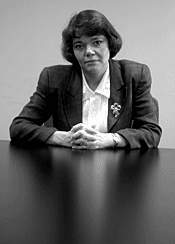 |
| Rebecca Randles is challenging Missouri's statute of limitations on abuse allegations. |
Despite the lack of recent abuse complaints, Randles believes that now is the time to bring her lawsuits. Continuing national media coverage of abuse in the church has spurred people to come forward who might not have in the past for various reasons. And she knows the constant news coverage may also have had an effect on attitudes among potential jurors and even judges.
"The time is ripe," Randles says.
It's just that attitude that infuriates Joe Maher, a Michigan man who founded a support group for Catholic priests accused of sexual abuse. "[Jeffrey Anderson] really started putting this whole process together," Maher says, charging Anderson and other lawyers with capitalizing on a church that is back on its heels. "They found a way to exploit the Catholic Church and these scandals to drum up a whole lot of business.... They come up with allegation after allegation. They are very good at this." When so many cases are filed, he says, they become too expensive for the church to investigate and defend. Often, the church chooses to settle. "If they can bring enough cases against the church, the church will settle," he says. "The church will not fight these things. That is a fact."
Randles denies that she's motivated by cynical reasons or that she'd bring a lawsuit without good reason. "I would never file a claim if I did not have a colorable claim," Randles says. "I believe [White]. I believe Kenny [Landes]. From a merit standpoint, these cases have merit. Since they have merit, what do we do for them?"
And if anyone can win these suits, it's Randles, says fellow local attorney Sharon Lowenstein. Lowenstein has written for the journal of the Missouri Bar Association about the challenge of filing childhood sexual-abuse cases.
"I don't know of anyone else in the state who has filed more cases having to do with this over the last ten years," Lowenstein says.
Bill Cownie, however, is skeptical about Randles' chances of convincing judges that the statute of limitations should count only after victims' memories were triggered by the nationwide scandal. "I would like to tell you that will work, but I don't think it will," Cownie says. The local lawyer has filed numerous child sexual-abuse, personal-injury cases. "The clock starts to run when you should have known you were damaged," he says. Realizing much later that the damage has occurred is no excuse, he adds, at least not in Missouri courts. And media coverage of priest scandals, as far as he can tell, hasn't affected how that law is interpreted.
"I think she has a long road, and it's all uphill," Cownie says. "I don't like saying that."
Randles, meanwhile, equates her nearly weekly announcements of lawsuits with the kind of confrontations that marked the civil rights movement of the 1950s. She is emerging as a reformer in the classic mold, taking her case as much to the public as to the courts.
And maybe, if Randles files enough lawsuits, Kansas Citians will come to believe that it's Boston all over again.
Any original material on these pages is copyright © BishopAccountability.org 2004. Reproduce freely with attribution.